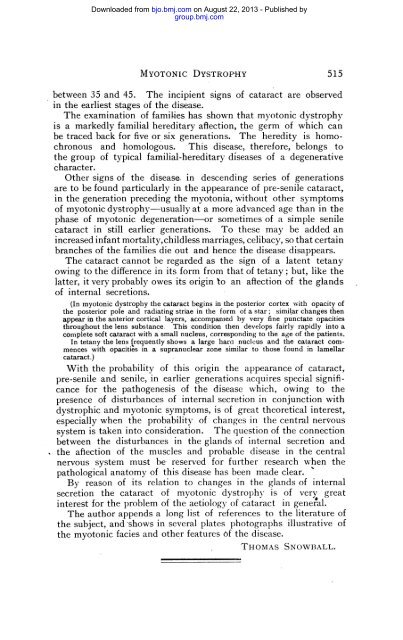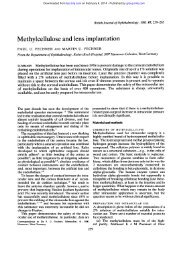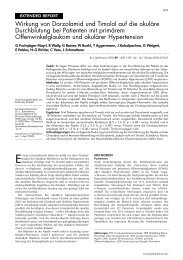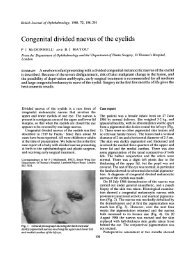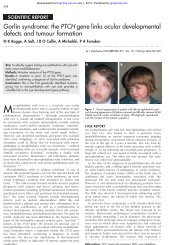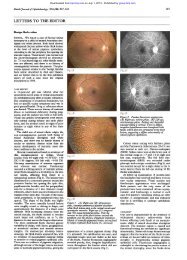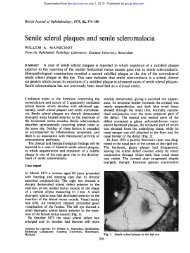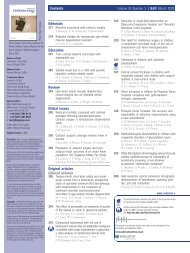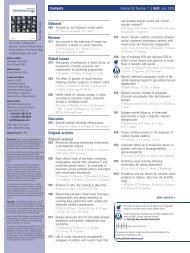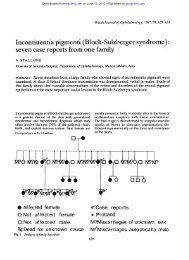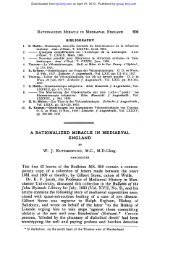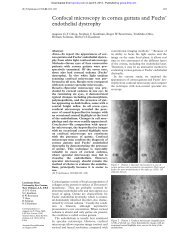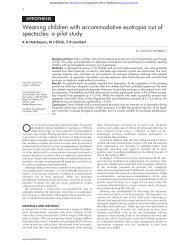ABSTRACTS - British Journal of Ophthalmology
ABSTRACTS - British Journal of Ophthalmology
ABSTRACTS - British Journal of Ophthalmology
Create successful ePaper yourself
Turn your PDF publications into a flip-book with our unique Google optimized e-Paper software.
Downloaded from bjo.bmj.com on August 22, 2013 - Published by<br />
group.bmj.com<br />
MYOTONIC DYSTROPHY<br />
between 35 and 45. The incipient signs <strong>of</strong> cataract are observed<br />
in the earliest stages <strong>of</strong> the disease.<br />
The examination <strong>of</strong> families has shown that myotonic dystrophy<br />
is a markedly familial hereditary aflection, the germ <strong>of</strong> which can<br />
be traced back for five or six generations. The heredity is homochronous<br />
and homologous. This disease, therefore, belongs to<br />
the group <strong>of</strong> typical familial-hereditary diseases <strong>of</strong> a degenerative<br />
character.<br />
Other signs <strong>of</strong> the disease. in descending series <strong>of</strong> generations<br />
are to be found particularly in the appearance <strong>of</strong> pre-senile cataract,<br />
in the generation preceding the myotonia, without other symptoms<br />
<strong>of</strong> myotonic dystrophy-usually at a more advanced age than in the<br />
phase <strong>of</strong> myotonic degeneration-or sometimnes <strong>of</strong> a simple senile<br />
cataract in still earlier generations. To these may be added an<br />
increased infant mortality, childless marriages, celibacy, so that certain<br />
branches <strong>of</strong> the families die out and hence the disease disappears.<br />
The cataract cannot be regarded as the sign <strong>of</strong> a latent tetany<br />
owing to the difference in its form from that <strong>of</strong> tetany; but, like the<br />
latter, it very probably owes its origin lto an aftection <strong>of</strong> the glands<br />
<strong>of</strong> internal secretions.<br />
(In myotonic dystrophy the cataract begins in the posterior cortex with opacity <strong>of</strong><br />
the posterior pole and radiating striae in the form <strong>of</strong> a star; similar changes then<br />
appear in the anterior cortical layers, accompanied by very fine punctate opacities<br />
throughout the lens substance This condition then develops fairly rapidly into a<br />
complete s<strong>of</strong>t cataract with a small nucleus, corresponding to the age <strong>of</strong> the patients.<br />
In tetany the lens frequently shows a large hard nucleus and the cataract commences<br />
with opacities in a supranuclear zone similar to those found in lamellar<br />
cataract.)<br />
With the probability <strong>of</strong> this origin the appearance <strong>of</strong> cataract,<br />
pre-senile and senile, in earlier generations acquires special significance<br />
for the pathogenesis <strong>of</strong> the disease which, owing to the<br />
presence <strong>of</strong> disturbances <strong>of</strong> internal secretion in conjunction with<br />
dystrophic and myotonic symptoms, is <strong>of</strong> great theoretical interest,<br />
especially when the probability <strong>of</strong> changes in the central nervous<br />
system is taken into consideration. The question <strong>of</strong> the connection<br />
between the disturbances in the glands <strong>of</strong> internal secretion and<br />
the aflection <strong>of</strong> the muscles and probable disease in the central<br />
nervous system must be reserved for further research when the<br />
pathological anatomy <strong>of</strong> this disease has been made clear.<br />
By reason <strong>of</strong> its relation to changes in the glands <strong>of</strong> internal<br />
secretion the cataract <strong>of</strong> myotonic dystrophy is <strong>of</strong> very great<br />
interest for the problem <strong>of</strong> the aetiology <strong>of</strong> cataract in general.<br />
The author appends a long list <strong>of</strong> references to the literature <strong>of</strong><br />
the subject, and shows in several plates photographs illustrative <strong>of</strong><br />
the myotonic facies and other features <strong>of</strong> the disease.<br />
THOMAS SNOWBALL.<br />
515


